4
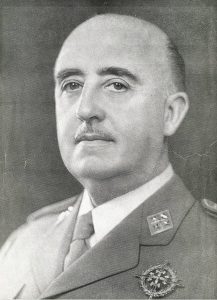
After the war, Francisco Franco became ‘Generalísimo’ (General of Generals) and ‘Caudillo’ (people’s leader). He would rule with an iron fist until his death in 1975. His dictatorship started and finished with executions. His authoritarian regime was based on values he considered quintessentially Spanish: the glorious military past that had made Spain a great empire, the Catholic dogma as guarantor of moral values, and a Spanish nationalism that rejected the existence of other languages and national communities within Spain.
His vision of Spain was implemented with the help of the army that had won the war for him. No dissidence was allowed. All parties were outlawed and a fascist party, Movimiento Nacional, encompassed all the political forces that were on his side (Falangists, monarchists and conservatives). He elevated the figure of the young founder of the Falangist party, José Antonio Primo de Rivera, executed at the beginning of the war, to the category of martyr for the cause. He was the son of former dictator General Miguel Primo de Rivera (1923-1930).
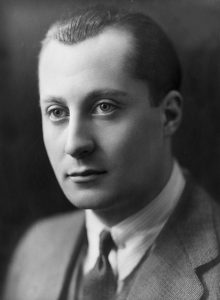
All labour unions were abolished and the ‘sindicatos verticales’ were created. These were unions that included workers and employers and were controlled by the State, which ultimately made all the decisions regarding labour relations. Basque, Catalan, and Galician languages and expressions of identity were outlawed, relegated to domestic life or to regional folkloric exhibitions.
Any other vision of Spain was considered the ‘anti-Spain’, and as such, it had to be eliminated.
4.1 POST-WAR YEARS (1940s)
“The summer of 1939 was an orgy of informing, private vendettas, and sanctioned executions.” (Mark Williams, The Story of Spain)
Once Franco won the war, a wave of political repression was unleashed by the new regime. 100,000 people were executed during the first years of the dictatorship. Around a million were arrested, and hundreds of thousands spent time in prison. The newly-established Brigada Político Social was the police force in charge of persecuting political crimes.
These were also the ‘años del hambre’ (hunger years), when people struggled to feed themselves due to a general food scarcity as a result of the destruction caused by the war. Many staples were strictly rationed. As a consequence, a black market blossomed that made some unscrupulous individuals very wealthy.
Despite the aid Hitler and Mussolini gave Franco, Spain did not enter the Second World War (1939-45). Franco was tempted to join in at the peak of German victories with an eye to expand Spain’s territories in Africa at the expense of France; however, he gave up the idea once Germany started to lose. It is also a fact that neither Germany nor Italy thought Spain would be a valuable ally. In any case, Franco made a token gesture allowing around 46,000 volunteers to join the División Azul to fight on the Nazi side against the Soviet Union. 5,000 of them died in Russia.
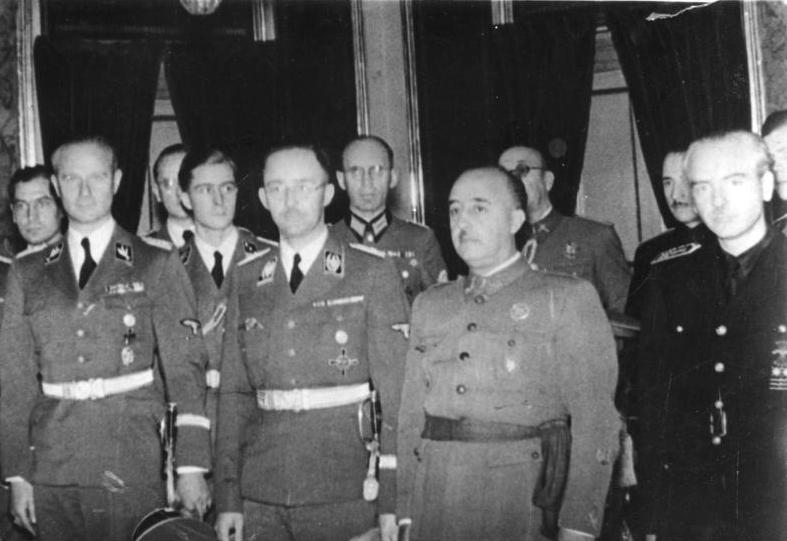
Once the Allies won the war, Spain was boycotted by the UN and excluded from the US postwar aid programme for Western Europe known as the Marshall Plan. Franco’s only international ‘friend’ was General Perón in Argentina, who lent money to Spain.
This international isolation led Spain into a policy of economic autarky or self-sufficiency that would last well into the 1950s. This policy emphasised the development of heavy industry such as shipyards, motor industry, mining and arms manufacturing. Imports and exports were heavily taxed and restricted by quotas. In time, the endemic lack of foreign investment and technology resulted in an outdated and inefficient industry. An economic crisis ensued with high deficit and inflation. By the late 50s it became clear that a new economic policy was required in order to invigorate a severely weakened economy.
Franco’s was a traditionalist, right-wing, Catholic dictatorship. As in any type of dictatorship, minds had to be controlled. Any form of media (press, TV, radio and films) were subjected to a thorough process of censorship in order to avoid democratic and left-wing political ideas and liberal social and sexual behaviours being broadcasted.
CULTURAL RESOURCES
No civil marriages were allowed, and divorce did not exist. Even adultery was punishable by law; although, typical of a patriarchal society, adultery committed by the husband was socially tolerated. Unsurprisingly, homosexuality was criminalised, as it was the case in most countries in Europe and elsewhere at the time.
Women’s rights were severely curtailed. Sadly, in this respect, Francoist Spain did not differ much from countries that were democratic at the time. Women were expected to devote their adult lives to marriage and motherhood. They were expected to give up work once married, not to do so would be severely frowned upon by society. A good wife was supposed to be always supportive of her husband, who was by his own right the head of the household. After the great loss of lives during the war, large families were encouraged by awarding employees significant financial bonuses for each child they produced. The total prohibition of contraceptive methods, sanctioned by the Catholic Church, was also a means to promote births, not to mention discourage extra-marital sex. A pregnancy out of wedlock stigmatised a woman for life.
Issues such as domestic violence or rape within the marriage were simply not talked about. These actions were not considered crimes, but private issues that happened within the family and should not be out in the public arena. Mistreated wives were usually advised by other family members, friends and priests to resign themselves to their lot, or, even worse, were looked upon as if they had done something to deserve such treatment.
In general, women were deprived of juridical personality: they could not open a bank account on their own, own a personal passport or even signed a contract.
CULTURAL RESOURCES
Guía de la buena esposa: 11 reglas para mantener a tu marido feliz (publicado en 1953)
4.2 LATE FRANCOISM (1950s-1975)
The isolation suffered by Francoist Spain after the Second World War was relaxed in the 1950s. The US saw Spain as a useful ally during the years of the Cold War between the two superpowers of the time (the US and the Soviet Union). Spain and the US struck a deal. Spain was to be admitted as a member of the UN and, as a gesture of good will, allowed the US to set up military bases on Spanish territory. Spain also received financial aid from America.
CULTURAL RESOURCES
¡Bienvenido Mr. Marshall! is a Spanish comedy (1953) about the American aid and national stereotypes. Read about it in this link.
These are two scenes from the film:
The villagers plan to ask the Americans for presents
The film is available from the library.
The self-sufficiency policy was ruining Spain and Franco decided some changes were needed. He appointed a new government made up of technocrats, mostly members of the Catholic organization Opus Dei. In order to save the economy, a new economic policy was implemented in 1959, the Plan de Estabilización. This plan promoted foreign trade and investment by reducing protectionist measures and offering low labour costs. Export and import tariffs were lowered and the national currency, the peseta, was devalued. As a consequence, the economy started to expand and continued growing until nearly the end of the dictatorship. This was known as the milagro económico español (Spanish economic miracle). When historians refer to this period, they call it aperturismo (opening) or desarrollismo (economic development).
The economic boom brought about industrial growth, although restricted to certain regions: Basque Country, Catalonia, Madrid and Valencia. Hundreds of thousands of young men and women moved from poor rural areas and settled in these rich industrial regions to work in factories. The new policy of aperturismo also allowed Spaniards to leave the country to find work in rich countries in the north of Europe such as France, Germany, Switzerland, Netherlands, Belgium and Britain. Over a million people left the country in search of work between 1960 and 1973, the year the world oil crisis hit Europe. Their remittances, together with the income from foreign tourism, contributed to redress the Spanish national balance of payments for years.
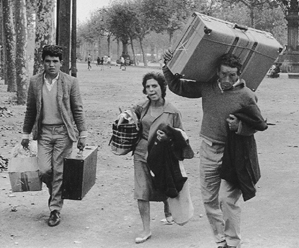
The devaluation of the peseta made sun-kissed Spain a very attractive country for foreign tourists from the rich north of Europe. Franco’s government embarked on a tourist campaign under the slogan ‘Spain is different’ to sell Spain as an exotic country within Europe where the nationals from cold countries could discover a new world of pleasures such as sunny beaches, sangría and flamenco, not to mention the barbaric but exciting practice of bullfighting. This stereotype has dogged Spain since then. The ecological damage caused by the unsightly high-rise apartment buildings and hotels built near the coasts and an unsustainable consumption of water started at this point and continues to this day. On the other hand, tourism coming from countries economically more developed and sexually more liberal had an impact on Spaniards’ economic and political aspirations and social mores, which in time contributed to erode the legitimacy of the dictatorship.
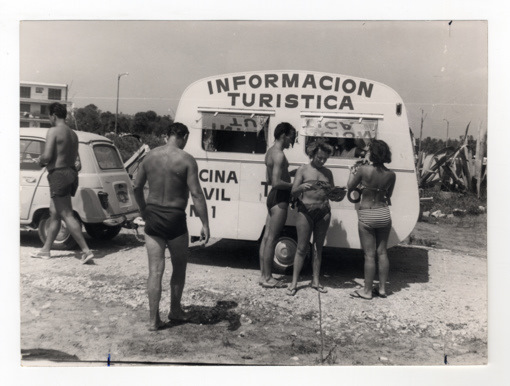
CULTURAL RESOURCES
Due to the economic expansion, more Spaniards could spend their money on luxury items such as TV sets and cars. In 1960 only 1% of households had a TV set, by 1969 the figure was 62%. The first family car in Spain, SEAT 600, hit the roads in 1957. Few working families could afford this car, but it was highly desirable. Many workers would hold several jobs, a practice known as pluriempleo, in order to save enough to afford a 600 or any other luxury consumer items.
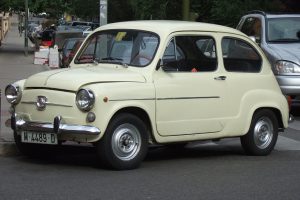
CULTURAL RESOURCES
A sign of modernity of the late Francoism was the production of Spanish music as you can see in these two links
Fórmula V: Eva María
Los diablos: Un rayo de sol
Conchita Velasco: Una chica ye ye
FILMS
El verdugo (1963) (available from the library) Black comedy about a retiring executioner in early 1960s Spain.
Los santos inocentes (1984) (available from the library) Drama about the extreme poverty, exploitation and humiliation suffered by a peasant family in a large rural estate in 1960s southern Spain.
4.3 DYING FRANCOISM
At the beginning of the dictatorship there was an active resistance against Franco. Some guerrillas called maquis were active until the mid-1960s. Also, the exiled members of the Basque government made great efforts to lobby the support of the US to overthrow Franco, but the American government had started to view Franco as a useful ally against the Soviet expansion in Europe and did not consider bringing democracy back to Spain as a priority at the time.
From the 1960s onwards, the dictatorship became less openly repressive. Spanish society was changing due to different foreign and domestic influences, and it had to adapt to survive. Spaniards learnt how other people in Western Europe lived a prosperous life in democratic countries through the contact with foreign tourists and the experiences of Spanish emigrants abroad. Inside the country things were also changing. Industrial workers demanded better conditions and were starting to organize themselves with the help of clandestine trade unions. They were taking part in strikes, even if these were illegal at the time. They were often supported by university students, who marched alongside them in demonstrations that sometimes were brutally repressed by the police. After the 1960s third-level education was becoming more and more accessible to young people from wider socio-economic backgrounds. Universities not only provided education but were also institutions where students became highly aware of political issues and, in many cases, active in clandestine left-wing political organizations.
Even the Catholic Church was changing. The Second Vatican Council (1962-65) aimed to modernise the Church, making it a more relevant institution in society. Many young priests fully embraced these ideas and involved themselves in social projects in deprived working-class areas and, in some cases, became politically active in unions and left-wing organizations.
Due to the relentless repression suffered by Basque and Catalan aspirations for self-government and full recognition of their languages and cultures, it is not surprising that the Basque Country and Catalonia were hubs of discontent against the regime. In the Basque case, this discontent led to the birth in 1959 of an armed organization, ETA, whose goal was the creation of an independent Socialist Basque Country. In 1973, just two years before Franco died, ETA struck a heavy blow against the regime when they assassinated the Prime Minister Admiral Carrero Blanco in a spectacular bomb attack. He was Franco’s right-hand man and his successor.
Franco ruled with an iron fist to the very end. Just two months before his death, when he was already very ill and fragile, he signed the death penalty of two members of ETA and three members of the left-wing revolutionary organization FRAP. They were accused of killing two members of the security forces in separate incidents and had been tried and sentenced in a military court without any guarantee of a fair trial. The investigation of the crimes was full of irregularities. The national and international pressure for Franco to overturn the death sentence was overwhelming. International political leaders and intellectuals and even the Pope asked him to grant clemency. There were protests in different cities in Europe. All was to no avail. The five men were shot by firing squad.
CULTURAL RESOURCES
A key event for the end of Franco’s dictatorship: Carrero Blanco’s assassination
Al Alba (1975) by Luis Eduardo Aute (love song that became a symbol for the last executions ordered by Franco in 1975)
L’estaca (1968) by Lluís Llach (Catalan song calling people to unite against the dictatorship and fight for freedom. It has been translated to many languages)
4.4 “TODO HA QUEDADO ATADO Y BIEN ATADO”
Franco finally died on November 20th 1975. He was 82. He was buried with full honours in the Valle de los Caídos, the Valley of the Fallen, a monumental basilica and memorial near Madrid built after the Civil War with mainly the forced labour of Republican political prisoners.
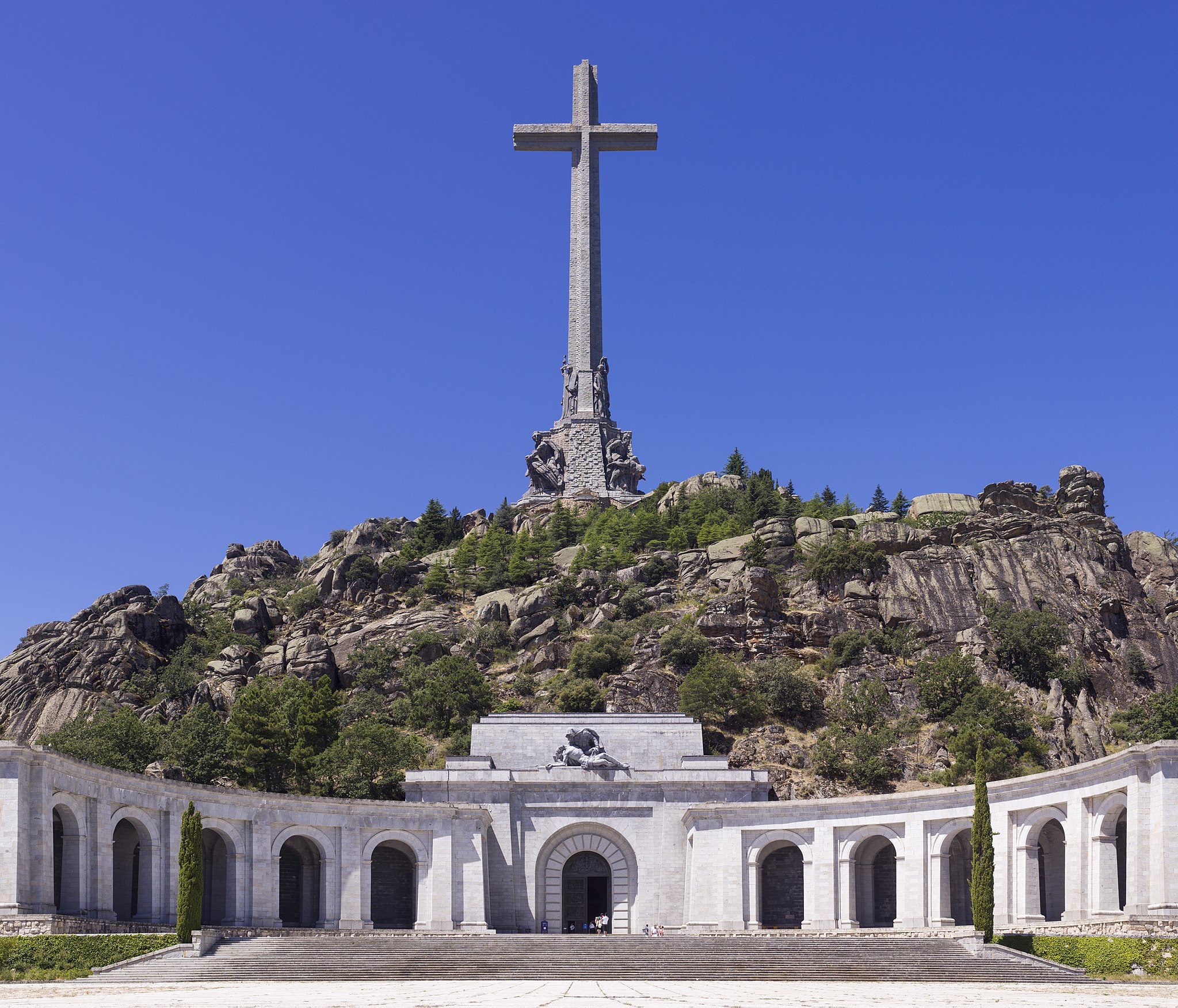
He had already planned the continuation of his regime after his death. In a Christmas speech in 1969 he pronounced the words “Todo ha quedado atado y bien atado” (Everything is tied up and well tied up) when referring to the then Prince Juan Carlos de Borbón as the future king of Spain. He always though Spain should be a monarchy and, bypassing the legitimate heir to the Crown, Juan Carlos’ father, he groomed the young prince for this purpose.
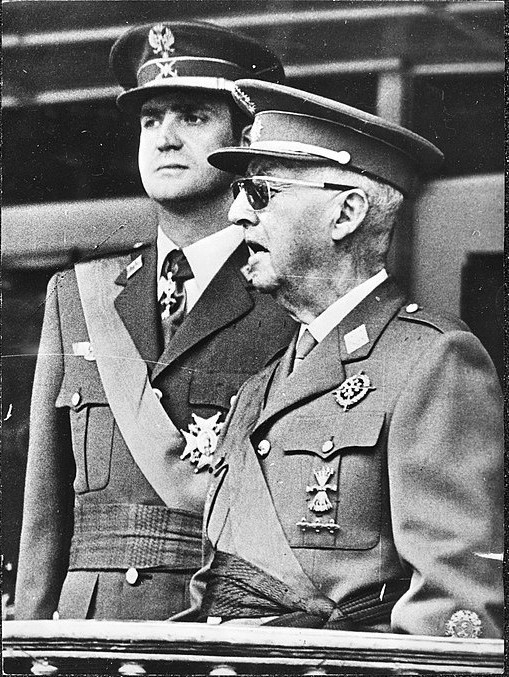
After Franco’s death Spain started its transition to democracy. Continuing with a dictatorial regime without Franco was unsustainable and counterproductive. However, the regime’s infrastructure (politicians, army officers, police force, judiciary, senior civil servants and officials) remained intact. The consequences of this would become apparent decades later. It took 32 years for a Spanish government to pass a law (Ley de la Memoria Histórica (2007)) that aimed to recover the historical memory of the Civil War and honour the victims on the Republican side.
More than a decade later, in 2018, a new Socialist government committed itself to remove Franco’s remains out of the basilica in the Valley of the Fallen. It was expected to be a rather straight-forward matter, but Franco’s powerful descendants and supporters resorted to all legal means available to them to prevent it from happening. Finally, in 2019 the Supreme Court ruled in favour of the removal and the remains were exhumed and moved by helicopter to a nearby cemetery. Franco’s living relatives were present at the exhumation and when the casket was out of the basilica shouts of ‘Viva Franco’ were heard. This chapter is not entirely over. The remains of over 30,000 Civil War combatants from both sides are buried there. The bodies of Republican soldiers were buried without their families’ consent and many of their descendants want them back. This is not the only issue pending. José Antonio Primo de Rivera, founder of the Spanish Fascist party Falange, is also buried in the basilica. Above all, what to do with the whole complex of the Valley of the Fallen needs to be decided, the general opinion being to turn it into a museum to the historic memory of the Civil War
LA DICTADURA FRANQUISTA (1939-1975)
Francisco Franco se convirtió en Generalísimo y Caudillo de España al ganar la guerra civil en 1939 y continuó gobernando como dictador hasta su muerte en noviembre de 1975. Su régimen autoritario se basaba en ideas tradicionalistas como el glorioso pasado imperial de España, la religión católica y el nacionalismo español. Todos los partidos políticos fueron prohibidos. Se formó el Movimiento Nacional, organización política que agrupaba a falangistas, conservadores católicos y monárquicos. Los sindicatos obreros también se prohibieron y fueron sustituidos por los llamados “sindicatos verticales”, organizaciones que incluían tanto a los trabajadores como a los empresarios y eran controlados por el Estado.
LA POSGUERRA (AÑOS 40)
Al acabar la guerra civil hubo una terrible oleada de represión que desembocó en miles de ejecuciones extrajudiciales y encarcelamientos por motivos políticos. La Brigada Político Social era la fuerza policial encargada de perseguir los delitos políticos.
Los años 40 fueron los “años del hambre” con racionamiento de los alimentos básicos y escasez de todo tipo de productos. El mercado negro cobró gran auge y enriqueció a muchos comerciantes sin escrúpulos.
Durante la Segunda Guerra Mundial Franco se negó a tomar parte en la guerra a favor de Hitler y Mussolini. Sin embargo, envió miles de voluntarios, la División Azul, que lucharon junto con el ejército alemán en contra de los soviéticos.
Una vez acabada la guerra mundial, la ONU boicoteó a España. Solo el general Perón de Argentina ayudó al régimen franquista ofreciéndole préstamos, los cuales España necesitaba urgentemente después de la destrucción causada por la guerra civil. Los EEUU pusieron en marcha un gran programa de ayuda financiera, el Plan Marshall, para ayudar a la economía de Europa Occidental, cuyos países habían quedado destruidos después de la Segunda Guerra Mundial. España quedó excluida de este programa de ayudas.
El gobierno de Franco fomentó la autarquía del país hasta bien entrada la década de los 50. Se promovió la industria pesada: astilleros, minería y manufactura de vehículos y armas. Se aplicaron tarifas a las importaciones y exportaciones, así como cuotas. La falta de inversión y tecnología extranjeras hizo que la industria quedara obsoleta en unos pocos años. Al final de la década de los 50 la economía española arrastraba un gran déficit y la inflación se disparó.
Para la dictadura era importante controlar la información y las ideas. La censura afectó a periódicos, televisión, radio y cine. La sexualidad también estaba controlada. La Iglesia condenaba toda relación fuera del matrimonio. Los actos homosexuales estaban penalizados, como en casi todos los países, aunque fueran democráticos. Las parejas solo podían casarse por la Iglesia y no había divorcio. El adulterio también estaba penalizado. Las mujeres se llevaron la peor parte en cuanto a falta de libertades y derechos. El adulterio cometido por la esposa estaba peor visto socialmente. El maltrato y violación dentro del matrimonio se consideraba algo privado que no debía salir de la esfera familiar. El papel de la mujer era el de esposa y madre sacrificada y generosa. Una mujer no podía tener su propio pasaporte, abrir una cuenta bancaria o firmar un contrato. Es necesario decir que la situación de las mujeres no era muy diferente en la mayoría de los países democráticos de la misma época.
SEGUNDA FASE DEL FRANQUISMO (AÑOS 50-1975)
En los años 50 empezó la Guerra Fría entre las dos superpotencias del momento: Estados Unidos y la Unión Soviética. EEUU empezó a ver a España como un aliado útil, a pesar de ser una dictadura, y se abrieron las relaciones entre ambos países. Los americanos establecieron varias bases militares en territorio español. La ONU admitió a España en su seno. Por fin, la tan deseada ayuda financiera americana se hizo realidad.
En 1959 se puso en marcha el Plan de Estabilización ante la situación desesperada de la economía española. Este plan redujo las medidas proteccionistas al mercado extranjero y permitió la entrada de inversiones extranjeras. La peseta fue devaluada para promover las exportaciones. Los bajos costes laborales favorecieron la entrada capital extranjero. Este periodo se conoce como “aperturismo” o “desarrollismo”.
Ciertas regiones de España (Cataluña, Madrid, País Vasco y Valencia) se estaban industrializando rápidamente. Cientos de miles de españoles de otras regiones dejaron su trabajo en el campo para asentarse en las zonas industriales. Otros cientos de miles de españoles se marcharon al extranjero, a países como Francia, Alemania, Suiza, Holanda, Bélgica y Gran Bretaña,) en busca de mejores condiciones de trabajo. Las remesas que enviaban fueron de gran ayuda a la hora de estabilizar la balanza de pagos de la economía española.
Otra valiosa fuente de ingresos fue el turismo. En los años 60 empieza el fenómeno del turismo de masas. El gobierno español hizo una atractiva campaña de promoción del turismo y cientos de miles de turistas extranjeros empezaron a llegar a España, sobre todo a sus playas.
El nivel de vida de los españoles empezó a mejorar. Las familias aspiraban a adquirir artículos de lujo como un televisor y un pequeño coche, como el SEAT 600 de producción nacional. Muchos trabajadores tenían dos o más empleos a la vez (“pluriempleo”) para poder ahorrar y permitirse estos productos.
EL FINAL DEL FRANQUISMO
Los últimos años del franquismo fueron menos represivos que los primeros años porque la sociedad española estaba cambiando. Los turistas extranjeros y los emigrantes españoles mostraron a los españoles que en los países vecinos se vivía mejor y había más libertad.
Cada vez había más huelgas de obreros reclamando mejores condiciones, muchas veces apoyados por estudiantes universitarios e incluso sacerdotes jóvenes, formados bajo las nuevas ideas modernizadoras del Segundo Concilio Vaticano (1962-65).
En 1959 se fundó la organización armada vasca ETA que luchaba por una Euskadi (País Vasco) independiente y socialista, en respuesta a años de represión franquista de la lengua y pueblo vascos. ETA dio el golpe más duro al régimen que nadie podía haber imaginado cuando asesinó al presidente del Gobierno, Almirante Carrero Blanco, mano derecha y posible sucesor de Franco, en un ataque espectacular en el centro de Madrid.
Franco murió en noviembre de 1975 a la edad de 82 años. Fue enterrado en la basílica del Valle de los Caídos, monumento que él mismo mandó construir después de la guerra civil. Años antes había elegido al joven príncipe Juan Carlos de Borbón como futuro rey de España a su muerte. Franco declaró: “Todo ha quedado atado y bien atado.”
Hubo que esperar 32 años después de su muerte para que viese la luz la Ley de la Memoria Histórica (2007) en la que se condenaba oficialmente al franquismo. En 2018 el gobierno socialista empezó a dar los pasos para exhumar los restos de Franco y trasladarlos a un lugar privado elegido por la familia. La familia se opuso desde el principio, pero en 2019 el Tribunal Supremo dio luz verde a la exhumación. Los restos de Franco están ahora en un cementerio cercano a Madrid. En la basílica siguen enterrados más de 30.000 soldados de ambos bandos muertos durante la guerra. Los muertos republicanos fueron enterrados sin el permiso de sus familias y muchos descendientes quieren exhumarlos. El fundador del partido fascista español Falange, José Antonio Primo de Rivera, también está enterrado allí. La última cuestión es qué hacer con el Valle de los Caídos en su totalidad. Una posibilidad es convertirlo en un museo de la memoria.
Media Attributions
- 651px-Francisco_Franco_en_1964
- 659px-FOTOGRAFIA_DE_JOSE_ANTONIO_PRIMO_DE_RIVERA
- Spanien, Heinrich Himmler bei Franco
- Emigrantes
- Foreign tourism
- 1024px-SEAT_600_white
- Franco and Juan Carlos
